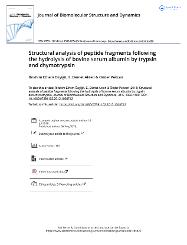| dc.contributor.author | Özyiğit, İbrahim Ethem | |
| dc.contributor.author | Akten, Ebru Demet | |
| dc.contributor.author | Pekcan, Önder | |
| dc.date.accessioned | 2019-06-27T08:02:04Z | |
| dc.date.available | 2019-06-27T08:02:04Z | |
| dc.date.issued | 2016 | |
| dc.identifier.issn | 0739-1102 | en_US |
| dc.identifier.issn | 1538-0254 | en_US |
| dc.identifier.uri | https://hdl.handle.net/20.500.12469/541 | |
| dc.identifier.uri | https://doi.org/10.1080/07391102.2015.1068712 | |
| dc.description.abstract | Peptide bond hydrolysis of bovine serum albumin (BSA) by chymotrypsin and trypsin was investigated by employing time-resolved fluorescence spectroscopy. As a fluorescent cross-linking reagent N-(1-pyrenyl) maleimide (PM) was attached to BSA through all free amine groups of arginine lysine and/or single free thiol (Cys34). Time-resolved fluorescence spectroscopy was used to monitor fluorescence decays analyzed by exponential series method to obtain the changes in lifetime distributions. After the exposure of synthesized protein substrate PM-BSA to chymotrypsin and trypsin it is observed that each protease produced a distinct change in the lifetime distribution profile which was attributed to distinct chemical environments created by short peptide fragments in each hydrolysate. The persistence of excimer emission at longer lifetime regions for chymotrypsin as opposed to trypsin suggested the presence of small-scale hydrophobic clusters that might prevent some excimers from being completely quenched. It is most likely that the formation of these clusters is due to hydrophobic end groups of peptide fragments in chymotrypsin hydrolysate. A similar hydrophobic shield was not suggested for trypsin hydrolysis as the end groups of peptide fragments would be either arginine or lysine. Overall in case the target protein's 3D structure is known the structural analysis of possible excimer formation presented here can be used as a tool to explain the differences in activity between two proteases i.e. the peak's intensity and location in the profile. Furthermore this structural evaluation might be helpful in obtaining the optimum experimental conditions in order to generate the highest amount of PM-BSA complexes. | en_US] |
| dc.language.iso | eng | en_US |
| dc.publisher | Taylor & Francis Inc | en_US |
| dc.rights | info:eu-repo/semantics/openAccess | en_US |
| dc.subject | Excimer Lifetime Distribution | en_US |
| dc.subject | N-(1-pyrenyl)maleimide | en_US |
| dc.subject | Bovine Serum Albumin | en_US |
| dc.subject | Chymotrypsin | en_US |
| dc.subject | Trypsin | en_US |
| dc.subject | Hydrolysis | en_US |
| dc.title | Structural Analysis of Peptide Fragments Following The Hydrolysis of Bovine Serum Albumin by Trypsin and Chymotrypsin | en_US |
| dc.type | article | en_US |
| dc.identifier.startpage | 1092 | en_US |
| dc.identifier.endpage | 1100 | |
| dc.relation.journal | Journal of Biomolecular Structure and Dynamics | en_US |
| dc.identifier.issue | 5 | |
| dc.identifier.volume | 34 | en_US |
| dc.department | Fakülteler, Mühendislik ve Doğa Bilimleri Fakültesi, Biyoinformatik ve Genetik Bölümü | en_US |
| dc.identifier.wos | WOS:000375005100015 | en_US |
| dc.identifier.doi | 10.1080/07391102.2015.1068712 | en_US |
| dc.identifier.scopus | 2-s2.0-84938613577 | en_US |
| dc.institutionauthor | Akten, Ebru Demet | en_US |
| dc.institutionauthor | Pekcan, Önder | en_US |
| dc.relation.publicationcategory | Makale - Uluslararası Hakemli Dergi - Kurum Öğretim Elemanı | en_US |
| dc.identifier.pmid | 26169062 | en_US |
















